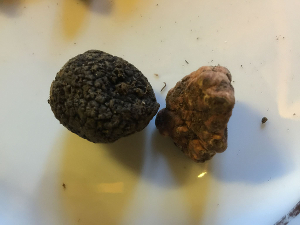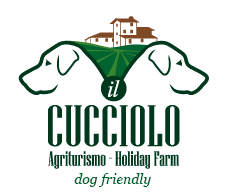 This winter, truffle people are missing the “bianchetto”, or “marzuolo” (Tuber Album Pico).
This winter, truffle people are missing the “bianchetto”, or “marzuolo” (Tuber Album Pico).
It is usually gathered between January and April but this year there is very little of it around, or it is too little and not at the right stage of ripeness. It is a pity because, even though it is a less precious truffle, its smell reminds vaguely the ones of the precious white one and the taste is subtle but distinctive and gives value to the simplest dishes like bread and butter or a sunny side up egg!
If you are lucky and you find some, like Breon did thanks to our dog Trilli and the new truffle puppies he is been training since November, you really feel like you found a treasure.
Another truffle which is typical of this time of the year is the “brumale”, which many call the “winter black” and collect between January and April. It doesn’t seem so appealing when first smelled and it is not a kind you can eat raw. But when sliced or grated and cooked slightly in oil it can be a good sauce for pasta.
The good luck of Umbria is that you can find a different kind of truffle in every season. That is why last week I thought about using the truffles that Breon found while training dogs to organise a “Lord Truffle Dinner” in Rome. We both wanted to propose two less known kind of truffles and share our appreciation for the treasures our land offers us.
I cleaned the “bianchetti” and Breon sliced them on my home made bread, slightly toasted and buttered. They were our crostini antipasto, together with some truffle cheese crostini and some chicken liver umbrian patè crostini.
We sliced the “brumale” as well and we put it in hot oil (not frying) where some garlic was cooking. Then I used the sauce to season my home made eggs noodles and the result was a veri delicate dish, where you could taste the particular flavour of earth (mushroom kind) and garlic of the “winter black”.
The second course didn’t have any truffle. I served local sausages with potatoes and a fresh cabbage, cut very thin and seasoned few hours before with lemon, oil and salt.
As dessert I fried the “castagnole” from Città di Castello, some fried pastries different than the one you find in Rome or in the south of italy: they are bigger, lighter and they are covered with honey while still hot.
Dinner was a success, also because the company was really nice even though not everybody knew each other. So, I decided to propose another one through the website “Gnammo”, when the apartment in Rome (that I manage for touristic rentals on Airbnb) is empty. It is a way for us to bring some of our Umbria to Rome, to the romans or the tourists visiting this eternal city, who wouldn’t have a chance to come and visit us in our Holiday Farm.
